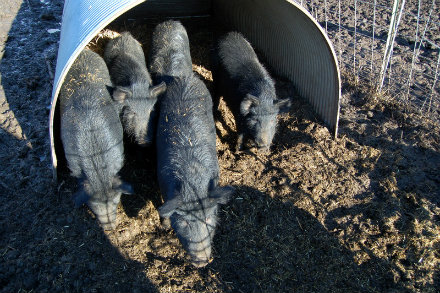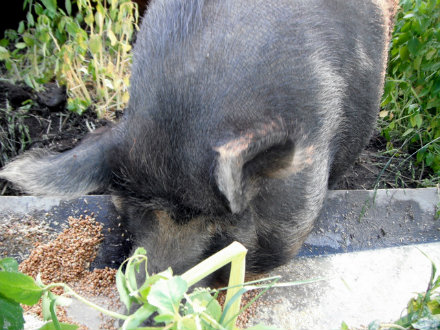AgriCulture bloggers Peter Davies and Mark Scherzer are the owners of Turkana Farms in Germantown, NY. This week Mark writes.

While spring is a time of new birth and a surging life force, sometimes it seems like farming during the season is at least as much about second takes, repairs, and responding to changes caused by winter's hard conditions. Tree limbs break and need to be sawed completely off or cut back even further; dead and fallen branches must be cleared. Water lines freeze and then need re-plumbing. Fence posts rot in the ground or get heaved up. Heaved up also are small boulders that last year were hidden in the soil but this year must be picked up and moved off to maximize pasturage for the grazing animals and to protect machinery. As you can imagine, this reality has its frustrations. Nowhere are these so apparent to me as in our pig-raising operation. Pigs are, in my opinion, relentless sources of chaos. They take perfectly beautiful green pastures and turn them, in relatively short order, into plowed-up expanses of holes and hills, constantly burrowing and rooting in the earth. Two weeks ago, as our helper Kyle and I were carrying a pig trough up one side of the pig pasture, my left leg suddenly disappeared, almost up to the knee, in a sink hole they had created digging for Lord knows what. Peter says they are after grubs and such, things that like damp, wet places.

But they don't stop with digging up the earth. Working principally with their powerful snouts, their teeth, and the brute force of their weight, pigs upend whatever human-created structures they encounter. Their shelters are essentially small metal Quonset huts which we secure to the ground with metal stakes. We got these to replace an old wooden hut we had used at first, a good part of which they either ate or demolished. We place their metal shelters carefully on higher, dry ground, to face south or east, to catch the morning and midday sun, perfect for pig snoozing in a sun trap all through the winter. No matter how ideally placed this arrangement is, it is almost inevitably undone over time. We frequently find that the pigs have used their haunches to raise the hut from its moorings to the ground and shift it askew. Sometimes the hut moves from high and dry ground to lower, wetter ground, even though the latter is far less comfortable for them. The instinct that causes them to shift things around this way is mysterious. It seems it's the activity itself, not the end result, that they are pursuing. While the moving of the huts is a sometime event, the attack on whatever vessels we use to provide them with water is a daily thing. In winter, we have tried numerous options to keep them with fresh water. Electric heaters are not even a possibility given what the pigs would likely do to the cord — and themselves — in the process. We've tried rubber water containers that we can turn upside down and jump on to break up the ice, remove it, and refill with fresh water; triangular plastic vessels that can be wired to their fence and from which we can chop out the ice to refill with water; metal containers dug partly into the ground. It doesn't matter. No matter what shape or how the water trough is secured, the pigs are adept at figuring out how to up-end it, empty it, and move it to an inaccessible part of their pen so that we have to climb in and retrieve it in order to keep them watered. Pigs are at least as intelligent as dogs, but there seems to be no training them to stop fooling around with the water vessels. Our frustration over how they treat their water containers led Peter to fix on a traditional wooden design he found in that 1893 farm classic, Harris on the Pig, by Joseph Harris. The Harris design is a long (six to eight feet) v-shaped trough, made up of two thick planks, roughly 3" thick by 6" wide, assembled in a V shape, with a wooden divider in the middle, creating two compartments, one for food and one for water. The V-shaped trough is fitted with perpendicular boards attached at each end, which provide a straight surface so the trough rests upright on the ground. Because of their bulk, their awkward shape, and their weight (probably 60 to 70 lbs.) they would seem to me almost impossible to move, especially as they are often mired in mud. Yet the pigs, in their enthusiasm for their feed, may stand in them, tipping them askew, or may, with their snouts, nose them up and tip them in a different direction. Ultimately, as impossible as this may seem, they get broken up. We have had to replace three already this spring.
.JPG)
Above all else, what is at risk from the pigs is the fencing that is intended to keep them in some place or out of some other place. They push out fencing and gates that are not strongly secured. They burrow under fencing panels and then with their snouts push the panels upward, pulling the T-posts to which they are affixed out of the ground. Electric lines can be helpful, but the the pigs have been known to bury them by heaping dirt on top of them, thus shorting the electric charge. Last week I noticed that Jane's litter of six piglets was nosing about in front of the pen where they were supposed to be confined with their mother, and noted the major escape hatch, burrowed under some of our metal fencing, through which they had exited. Kyle fixed that during the week. Then on Saturday, I saw more escape hatches, some newly created since the week before, and spent an hour or so securing them with pieces of old broken wooden boxes. Yet Sunday, when I went down to feed them, all six piglets were out in the back pasture, having gone though even more escape routes in the fencing that had passed unnoticed before. Peter and I spent four hours Sunday morning re-pounding T-posts into the ground, re-securing fence panels to those T posts, and sometimes adding a second layer of fencing to the first or putting down mesh and small pieces of old paneling in gaps near the base, places that might tempt a piglet to dig out. How long this repair job will last is pure conjecture. About three weeks ago, exasperated after moving the five feeder pigs born last year back to their summer pasture, and hearing that within hours they were rampaging around terrorizing the cows in the pasture, I told Peter I had had it with breeding pigs. Either they go, or I do. He said he'd weigh the pros and cons carefully and with due deliberation and get back to me. I'm still awaiting a decision. In the event Peter decides, as I suspect he will, to keep the pigs, I will do my best to train Vernon, our people-friendly boar (pictured above), to take over my turn every other week doing an essay. Vernon is a charmer. It's not every 400-pound plus tusked board who comes over to be petted, to have his ears rubbed, and to smile at visitors. People love him, and I'm sure he has great insights to impart to you. But I dread to think what he will do to the office and the computer.









